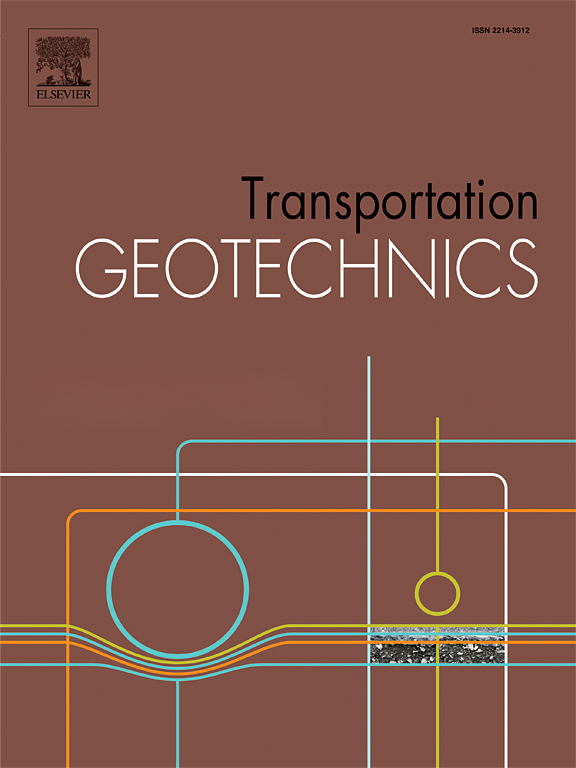聚苯乙烯垫层与土工格栅-土工布复合地基分离桩筏基础性能评价
IF 5.5
2区 工程技术
Q1 ENGINEERING, CIVIL
引用次数: 0
摘要
基础系统对于确保结构稳定性至关重要,特别是在具有挑战性的岩土条件下。本研究介绍了一种分离桩筏(DPR)基础系统,该系统采用聚苯乙烯缓冲平台,并用土工格栅和土工布层加固,以增强荷载分布,减少差异沉降,并提高整体性能。提出的DPR系统通过降低筏板-桩界面的刚度和促进更均匀的荷载传递来解决传统桩筏基础的局限性。研究方法包括使用PLAXIS-3D的数值模拟和实验室实验来评估DPR系统的性能。对聚苯乙烯垫层、土工格栅和土工织物的材料性能进行了表征,并定义了边界条件来模拟真实的加载场景。在不同荷载条件下,与传统垂直桩筏(VPR)和破碎桩筏(BPR)系统进行了对比分析。结果表明,DPR系统最大承受荷载为18.2 kN,沉降量为10 mm,优于连接系统的性能。沉降效率约为32%,显著高于常规体系(10-17)%的效率。此外,DPR系统表现出优化的刚度,与连接系统的17 kN相比,DPR系统的等效刚度为1 kN,并将单位表面摩擦降低至-2 kPa,确保有效的负载扩散。研究认为,DPR基础体系通过集成先进的土工合成材料,提供了卓越的承载能力,增强了沉降控制,提高了结构效率,为现代基础工程提供了创新的解决方案。本文章由计算机程序翻译,如有差异,请以英文原文为准。
Performance Evaluation of Disconnected Piled raft foundation Incorporated with Polystyrene Cushion and Hybrid Geogrid-Geotextile Base
Foundation systems are critical to ensure structural stability, particularly in challenging geotechnical conditions. This study introduces a disconnected piled raft (DPR) foundation system incorporating a polystyrene cushion platform reinforced with geogrid and geotextile layers to enhance load distribution, minimize differential settlement, and improve overall performance. The proposed DPR system addresses the limitations of conventional piled raft foundations by reducing the rigidity at the raft-pile interface and promoting more uniform load transfer. The research methodology involved numerical modelling using PLAXIS-3D and laboratory experiments to evaluate the performance of the DPR system. Material properties of the polystyrene cushion, geogrid, and geotextile were characterized, and boundary conditions were defined to simulate realistic loading scenarios. Comparative analysis with traditional vertical piled raft (VPR) and battered piled raft (BPR) systems was conducted under varying load conditions. Results demonstrated that the DPR system supported a maximum load of 18.2 kN with a settlement of 10 mm, surpassing the performance of connected systems. The settlement efficiency ratio of approximately 32% was significantly higher than the (10-17) % efficiency observed in conventional systems. Additionally, the DPR system exhibited optimized stiffness, achieving equivalent stiffness at 1 kN compared to 17 kN for connected systems, and reduced unit skin friction to -2 kPa, ensuring effective load diffusion. The study concludes that the DPR foundation system offers an innovative solution for modern foundation engineering, providing superior load-bearing capacity, enhanced settlement control, and improved structural efficiency through the integration of advanced geosynthetic materials.
求助全文
通过发布文献求助,成功后即可免费获取论文全文。
去求助
来源期刊

Transportation Geotechnics
Social Sciences-Transportation
CiteScore
8.10
自引率
11.30%
发文量
194
审稿时长
51 days
期刊介绍:
Transportation Geotechnics is a journal dedicated to publishing high-quality, theoretical, and applied papers that cover all facets of geotechnics for transportation infrastructure such as roads, highways, railways, underground railways, airfields, and waterways. The journal places a special emphasis on case studies that present original work relevant to the sustainable construction of transportation infrastructure. The scope of topics it addresses includes the geotechnical properties of geomaterials for sustainable and rational design and construction, the behavior of compacted and stabilized geomaterials, the use of geosynthetics and reinforcement in constructed layers and interlayers, ground improvement and slope stability for transportation infrastructures, compaction technology and management, maintenance technology, the impact of climate, embankments for highways and high-speed trains, transition zones, dredging, underwater geotechnics for infrastructure purposes, and the modeling of multi-layered structures and supporting ground under dynamic and repeated loads.
 求助内容:
求助内容: 应助结果提醒方式:
应助结果提醒方式:


